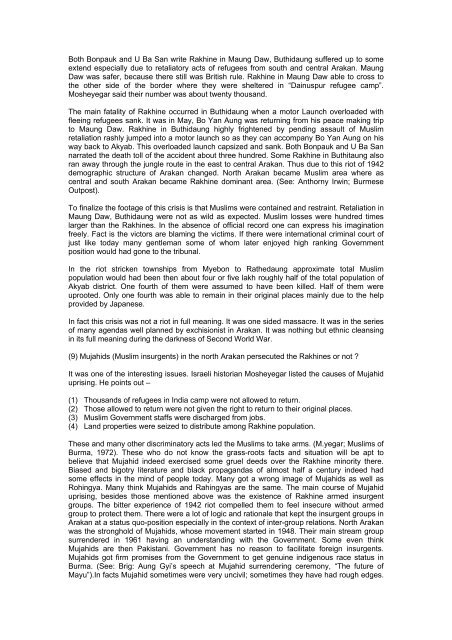Rohingya History: Myth and Reality - Rohingya Society In Malaysia
Rohingya History: Myth and Reality - Rohingya Society In Malaysia
Rohingya History: Myth and Reality - Rohingya Society In Malaysia
Create successful ePaper yourself
Turn your PDF publications into a flip-book with our unique Google optimized e-Paper software.
Both Bonpauk <strong>and</strong> U Ba San write Rakhine in Maung Daw, Buthidaung suffered up to some<br />
extend especially due to retaliatory acts of refugees from south <strong>and</strong> central Arakan. Maung<br />
Daw was safer, because there still was British rule. Rakhine in Maung Daw able to cross to<br />
the other side of the border where they were sheltered in “Dainuspur refugee camp”.<br />
Mosheyegar said their number was about twenty thous<strong>and</strong>.<br />
The main fatality of Rakhine occurred in Buthidaung when a motor Launch overloaded with<br />
fleeing refugees sank. It was in May, Bo Yan Aung was returning from his peace making trip<br />
to Maung Daw. Rakhine in Buthidaung highly frightened by pending assault of Muslim<br />
retaliation rashly jumped into a motor launch so as they can accompany Bo Yan Aung on his<br />
way back to Akyab. This overloaded launch capsized <strong>and</strong> sank. Both Bonpauk <strong>and</strong> U Ba San<br />
narrated the death toll of the accident about three hundred. Some Rakhine in Buthitaung also<br />
ran away through the jungle route in the east to central Arakan. Thus due to this riot of 1942<br />
demographic structure of Arakan changed. North Arakan became Muslim area where as<br />
central <strong>and</strong> south Arakan became Rakhine dominant area. (See: Anthorny Irwin; Burmese<br />
Outpost).<br />
To finalize the footage of this crisis is that Muslims were contained <strong>and</strong> restraint. Retaliation in<br />
Maung Daw, Buthidaung were not as wild as expected. Muslim losses were hundred times<br />
larger than the Rakhines. <strong>In</strong> the absence of official record one can express his imagination<br />
freely. Fact is the victors are blaming the victims. If there were international criminal court of<br />
just like today many gentleman some of whom later enjoyed high ranking Government<br />
position would had gone to the tribunal.<br />
<strong>In</strong> the riot stricken townships from Myebon to Rathedaung approximate total Muslim<br />
population would had been then about four or five lakh roughly half of the total population of<br />
Akyab district. One fourth of them were assumed to have been killed. Half of them were<br />
uprooted. Only one fourth was able to remain in their original places mainly due to the help<br />
provided by Japanese.<br />
<strong>In</strong> fact this crisis was not a riot in full meaning. It was one sided massacre. It was in the series<br />
of many agendas well planned by exchisionist in Arakan. It was nothing but ethnic cleansing<br />
in its full meaning during the darkness of Second World War.<br />
(9) Mujahids (Muslim insurgents) in the north Arakan persecuted the Rakhines or not ?<br />
It was one of the interesting issues. Israeli historian Mosheyegar listed the causes of Mujahid<br />
uprising. He points out –<br />
(1) Thous<strong>and</strong>s of refugees in <strong>In</strong>dia camp were not allowed to return.<br />
(2) Those allowed to return were not given the right to return to their original places.<br />
(3) Muslim Government staffs were discharged from jobs.<br />
(4) L<strong>and</strong> properties were seized to distribute among Rakhine population.<br />
These <strong>and</strong> many other discriminatory acts led the Muslims to take arms. (M.yegar; Muslims of<br />
Burma, 1972). These who do not know the grass-roots facts <strong>and</strong> situation will be apt to<br />
believe that Mujahid indeed exercised some gruel deeds over the Rakhine minority there.<br />
Biased <strong>and</strong> bigotry literature <strong>and</strong> black propag<strong>and</strong>as of almost half a century indeed had<br />
some effects in the mind of people today. Many got a wrong image of Mujahids as well as<br />
<strong>Rohingya</strong>. Many think Mujahids <strong>and</strong> Rahingyas are the same. The main course of Mujahid<br />
uprising, besides those mentioned above was the existence of Rakhine armed insurgent<br />
groups. The bitter experience of 1942 riot compelled them to feel insecure without armed<br />
group to protect them. There were a lot of logic <strong>and</strong> rationale that kept the insurgent groups in<br />
Arakan at a status quo-position especially in the context of inter-group relations. North Arakan<br />
was the stronghold of Mujahids, whose movement started in 1948. Their main stream group<br />
surrendered in 1961 having an underst<strong>and</strong>ing with the Government. Some even think<br />
Mujahids are then Pakistani. Government has no reason to facilitate foreign insurgents.<br />
Mujahids got firm promises from the Government to get genuine indigenous race status in<br />
Burma. (See: Brig: Aung Gyi’s speech at Mujahid surrendering ceremony, “The future of<br />
Mayu”).<strong>In</strong> facts Mujahid sometimes were very uncivil; sometimes they have had rough edges.


